List of Presidents of South Korea
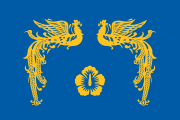
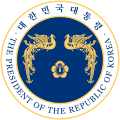
- To avoid confusion, all the names on this list follow the Eastern order convention (family name first, given name second) for consistency.
Since the establishment of the Government of the Republic of Korea which is commonly known as South Korea in 1948, twelve people have served nineteen terms as President of South Korea. Under the Constitution of South Korea, the president is the country's head of state as well as its head of government. The president is also the commander-in-chief of the Armed Forces.
Prior to the establishment of the First Republic in 1948, the Provisional Government of the Republic of Korea established in Shanghai in September 1919 as the continuation of several governments proclaimed in the aftermath of March 1st Movement earlier that year coordinated Korean people's resistance against Japan during the Japanese occupation of Korea. The legitimacy of the Provisional Government has been recognised and succeeded by South Korea in the latter's original Constitution of 1948 and the current Constitution of 1988. Nine people have served twenty-four terms as Heads of State (with varying titles) of the Provisional Government between September 1919 and August 1948.
The presidential term has been set at five years since 1988. It was previously set at four years from 1948 to 1972, six years from 1972 to 1981, and seven years from 1981 to 1988. Since 1981, the president has been barred from reelection. The president must be a South Korean citizen, at least 40 years old, who has lived in South Korea for 5 years.
List of Heads of State of the Provisional Government
Heads of Governments Proclaimed after the March 1st Movement (1919)
Following the March 1st Movement with the Declaration of Independence, several groups within Korea and Korean diaspora proclaimed the establishment of republican governments, claiming to be the representation of the Korean people. Three of these proclaimed governments remained active in the months thereafter and amalgamated to form the unified Provisional Government of the Republic of Korea.
Four other governments were proclaimed in the aftermaths of the March 1st Movement but these did not have significant activity following the proclamation.
- The Provisional Government of the Republic of Korea (조선민국임시정부) proclaimed in Seoul on 19 April 1919: President (정도령) Son Byong-hi
- The Government of the New Republic of Korea (신한민국정부) proclaimed in Northwestern Korea including Pyongyang on 17 April 1919: Consul (집정관) Lee Dong-hwi
- The Republican Government of Korea (고려공화정부) proclaimed in Manchuria in early 1919
- The Provisional Government in Jiandao (간도임시정부) proclaimed in Jilin in early 1919
There was a further plan to proclaim The Civil Government of Korea (대한민간정부) on 1 April 1919 with Son Byong-hi as the President (대통령) in the anticipation of the success of the March 1st Movement; the planned proclamation was not distributed.
Consul-President of the Republic of Korea (Seoul Government)
The Republic of Korea (대한공화국) was proclaimed in Seoul on April 23, 1919, by 24 representativse gathered from 13 provinces of Korea. It is commonly known as the Seoul Government (한성정부). Syngman Rhee was elected by the assembled representatives as the Consul-President (집정관 총재). Rhee sent letters to foreign heads of state including those of the United States, Japan and the United Kingdom notifying these countries of the proclamation of the Republic and his election as the President. It was agreed at the time of the amalgamation with the Governments of Shanghai and Vladivostok that the new unified Provisional Government is the successor government of the legitimacy of the Seoul Government.
| No. | Portrait | Name (Birth–Death) |
Term of Office | Deputy | |
|---|---|---|---|---|---|
| 1 | 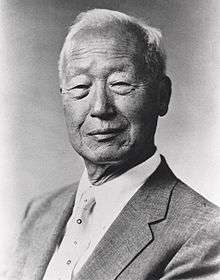 |
Rhee Syngman 이승만 李承晩 (1875–1965) |
23 April 1919 |
11 September 1919 |
Premier-President Lee Dong-hwi |
| Also the Head of the Shanghai Government as the Chancellor and the Prime Minister of the Vladivostok Government under President Son Byong-hi before the amalgamation of the governments. Became the President of the unified Provisional Government on 11 September 1919 but impeached in 1925. Chairman of the State Council of the Provisional Government 1947-1948. President of South Korea 1948-1960. | |||||
Chancellors of the Provisional Government of the Republic of Korea (Shanghai Government)
The Provisional Government of the Republic of Korea (대한민국 임시정부) was established in Shanghai on 11 April 1919 as a result of the first meeting of the Provisional Assembly from the previous night (10 April 1919). Syngman Rhee was elected as the Chancellor (국무총리). The Government was amalgamated with the Governments proclaimed in Seoul and Vladivostok on 11 September 1919 to form the unified Provisional Government.
| No. | Portrait | Name (Birth–Death) |
Term of Office | Deputy | |
|---|---|---|---|---|---|
| 1 |  |
Rhee Syngman 이승만 李承晩 (1875–1965) |
11 April 1919 |
23 April 1919 |
|
| Also the Head of State of the Seoul Government as the Consul-President and the Prime Minister of the Vladivostok Government under President Son Byong-hi before the amalgamation of the governments. Became the President of the unified Provisional Government on 11 September 1919 but impeached in 1925. Chairman of the State Council of the Provisional Government 1947-1948. President of South Korea 1948-1960. | |||||
| 2 | Yi Dong-nyeong 이동녕 李東寧 (1869–1940) |
23 April 1919 |
28 June 1919 |
||
| Later served for twelve years over four different periods as the Head of State of the unified Provisional Government. Died in Office in 1940. | |||||
| From 28 June 1919 until 27 August 1919, Director-General of the Interior Ahn Changho (안창호 / 安昌浩) was Acting Chancellor. | |||||
| 3 | Yi Dong-hwi 이동휘 李東輝 (1873–1935) |
27 August 1919 |
11 September 1919 |
||
| Continued to serve as the Prime Minister of the Unified Provisional Government after September 1919 under President Syngman Rhee | |||||
President of the National Congress of Korea (Vladivostok Government)
The National Congress of Korea (대한국민의회) was proclaimed in Vladivostok on 17 March 1919 by the Korean diaspora living in Primorsky Krai, as the re-organisation of the Korean Central Assembly (한족중앙총회). Son Byong-hi, the leader of 33 representatives who signed the Korean Declaration of Independence on 1 March 1919, was elected as the President. The government was amalgamated with the governments proclaimed in Seoul and Shanghai on 11 September 1919.
| No. | Portrait | Name (Birth–Death) |
Term of Office | Deputy | |
|---|---|---|---|---|---|
| 1 | 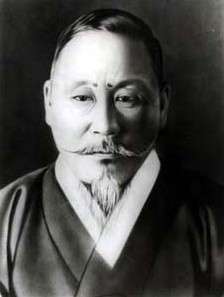 |
Son Byong-hi 손병희 孫秉熙 (1861-1922) |
17 March 1919 |
11 September 1919 |
Vice President Park Young-ho Prime Minister Syngman Rhee |
| The leader of the 33 representatives who signed the Korean Declaration of Independence during the March 1st Movement. The Head of Cheondogyo 1897-1908. He was in Japanese custody throughout the term as the President, having been arrested in the March 1st Movement. | |||||
Heads of State of the Provisional Government of the Republic of Korea (1919-1948)
Three of the Governments proclaimed in 1919 continued to be active in the months after the March 1st Movement; the Governments proclaimed in Seoul, Shanghai and Vladivostok. After a period of negotiations, members of these three governments agreed to form the unified Provisional Government in Shanghai, with succession of the legitimacy of the Seoul Government and bringing the members of the Vladivostok legislature into the Shanghai legislature. The unified Provisional Government of the Republic of Korea was established on 11 September 1919 with a new constitution.
The forms of the government from September 1919 were:
- Presidency (대통령제): 1919-1925
- Presidency of the Governance (국무령제): 1925-1927
- State Council Directory (국무위원제): 1927-1940
- Chairpersonship of the State Council (국무위원회 주석제): 1940-1948
In total, nine people served twenty-four terms as the Heads of States of the Provisional Government between September 1919 and August 1948, when the last Chairman of the State Council Syngman Rhee became the first President of South Korea.
| No. | Portrait | Name (Birth–Death) |
Term | Term of Office | Political Party | Deputy | |
|---|---|---|---|---|---|---|---|
| Presidents (대통령) | |||||||
| 1 |  |
Rhee Syng-man 이승만 李承晩 (1875–1965) |
1 | 11 September 1919 |
1922 | Prime Minister Yi Dong-hwi Yi Dong-nyeong (acting) Shin Kyu-sik Roh Baek-lin Kim Koo (acting) Yi Dong-nyeong Park Eun-sik | |
| 2 | 1922 | 23 March 1925 | |||||
| From 6 June 1924 until 11 December 1924, Prime Minister Yi Dong-nyeong (이동녕 / 李東寧) served as the Acting President for Syngman Rhee. | |||||||
| From 11 December 1924 until 23 March 1925, Prime Minister Park Eun-sik (박은식 / 朴殷植) served as the Acting President for Syngman Rhee. | |||||||
| The first President of the unified Provisional Government. Previously the Consul-President of the Seoul Government and the Chancellor of the Shanghai Government, and the Prime Minister under President Son Byong-hi of the Vladivostok Government. Impeached in 1925. Later became the last Chairman of the State Council (1947) before becoming the first Speaker of the Constituent Assembly and then the first President of the Republic of Korea (1948-1960). The first Korean to earn a Ph.D from a University of the Western World (Princeton) in 1910. The Korean War from 1950 to 1953. Forced to resign in the April Revolution of 1960 and died in exile in Hawaii in 1965 | |||||||
| 2 | Park Eun-sik 박은식 朴殷植 (1859-1922) |
3 | 23 March 1925 |
7 April 1925 |
Prime Minister Roh Baek-lin | ||
| Elected after the impeachment of Syngman Rhee; the Constitutional amendment of 1925. | |||||||
| Presidents of Governance (국무령) | |||||||
| (2) | Park Eun-sik 박은식 朴殷植 (1859-1922) |
4 | 7 April 1925 |
26 September 1925 |
Prime Minister Roh Baek-lin | ||
| During September 1925, Director-General of the Interior Lee Yu-pil (이유필 / 李裕弼) served as the Acting President. | |||||||
| Died two months after leaving office | |||||||
| 3 |  |
Yi Sang-ryong 이상룡 李相龍 (1858-1932) |
5 | 26 September 1925 |
18 February 1926 |
||
| Resigned due to difficulties forming the cabinet | |||||||
| 4 | Yang Gi-tak 양기탁 梁起鐸 (1871-1938) |
6 | 18 February 1926 |
29 April 1926 |
The Revolutionary Party of Korea (고려혁명당) | ||
| Resigned | |||||||
| 5 | Yi Dong-nyeong 이동녕 李東寧 (1869-1940) |
7 | 29 April 1926 |
3 May 1926 |
|||
| Resigned | |||||||
| 6 | 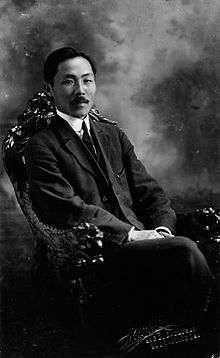 |
Ahn Changho 안창호 安昌浩 (1878-1938) |
8 | 3 May 1926 |
16 May 1926 |
||
| Resigned due to difficulties forming the cabinet | |||||||
| (5) | Yi Dong-nyeong 이동녕 李東寧 (1869-1940) |
9 | 16 May 1926 |
7 July 1926 |
|||
| Resigned | |||||||
| 7 | Hong Jin 홍진 洪震/洪鎭 (1877-1946) |
10 | 7 July 1926 |
14 December 1926 |
|||
| Resigned due to conflict within the Korean resistance. Also served as the Speaker of the Provisional Assembly | |||||||
| 8 | 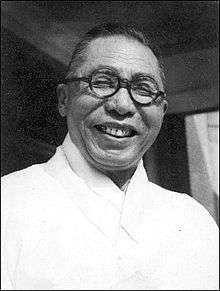 |
Kim Koo 김구 金九 (1876-1949) |
11 | 14 December 1926 |
11 April 1927 |
||
| The Constitutional amendment of 1927. | |||||||
| Chairpersons of the State Council Directory (국무회의 주석) | |||||||
| (8) |  |
Kim Koo 김구 金九 (1876-1949) |
12 | 11 April 1927 |
18 August 1927 |
||
| The first Chairman of the State Council Directory under the Constitution of 1927, where the Chairperson is the first among equals in the directory of state councillors | |||||||
| (5) | Yi Dong-nyeong 이동녕 李東寧 (1869-1940) |
13 | 19 August 1927 |
October 1930 |
Korean Independence Party (한국독립당) | ||
| 14 | October 1930 |
5 March 1933 |
President of Governance Kim Koo | ||||
| The first person to have served longer than a year since 1925 | |||||||
| 9 | Song Byeong-jo 송병조 宋秉祚 (1877-1942) |
15 | 5 March 1933 |
24 June 1933 |
President of Governance Kim Koo | ||
| 16 | 24 June 1933 |
October 1933 | |||||
| Also served as the Speaker of the Provisional Assembly | |||||||
| (5) | Yi Dong-nyeong 이동녕 李東寧 (1869-1940) |
17 | October 1933 |
October 1935 |
Korean Independence Party (한국독립당) | President of Governance Yang Gi-tak | |
| 18 | October 1935 |
23 October 1939 |
Korean National Party (한국국민당) | ||||
| 19 | 23 October 1939 |
13 March 1940 |
Chief of the Government Staff Ryu Dong-ryeol | ||||
| Died in Office | |||||||
| (8) |  |
Kim Koo 김구 金九 (1876-1949) |
20 | 13 March 1940 |
8 October 1940 |
Korean Independence Party (한국독립당) | Chief of the Government Staff Ryu Dong-ryeol |
| The Constitutional Amendment of 1940 | |||||||
| Chairpersons of the State Council (국무위원회 주석) | |||||||
| (8) |  |
Kim Koo 김구 金九 (1876-1949) |
21 | 9 October 1940 |
22 April 1944 |
Korean Independence Party (한국독립당) | Deputy Chairman Kim Kyu-sik |
| 22 | 22 April 1944 |
3 March 1947 | |||||
| Korean Liberation Army in 1940. The Declaration of War against Japan and Germany 1941. The Constitutional Amendment of 1944. Return to Korea 1945 after the end of World War II which brought liberation to Korea | |||||||
| (1) |  |
Rhee Syngman 이승만 李承晩 (1875-1965) |
23 | 3 March 1947 |
September 1948 |
National Association for the Rapid Realisation of Korean Independence | Deputy Chairman Kim Koo |
| 24 | September 1947 |
15 August 1948 | |||||
| Previously the first President of the Provisional Government 1919-1925 before being impeached. The Speaker of the Constituent Assembly 1948. The first President of South Korea 1948-1960. | |||||||
List of Presidents of the Republic of Korea
Conservative Centrist Liberal Military Independent
| No. | Portrait | Name (Birth–Death) |
Term | Term of Office | Electoral mandate | Political party | ||
|---|---|---|---|---|---|---|---|---|
| President of the First Republic | ||||||||
| 1 |  |
Rhee Syng-man I (Yi) Seungman 이승만 李承晩 (1875–1965) |
1 | 24 July 1948 |
14 August 1952 |
1948 — 91.8% | NARRKI (1948–1951) Liberal (1951–1960) | |
| 2 | 15 August 1952 |
14 August 1956 |
1952 — 74.6% | |||||
| 3 | 15 August 1956 |
27 April 1960 |
1956 — 70.0% | |||||
| 1960 — 100.0% | ||||||||
| The only President of the First Republic of Korea. Previously the President (1919-1925) and the Chairman of the State Council (1947-1948) of the Provisional Government. The Speaker of the Constituent Assembly (1948). The first Korean to earn a Ph.D from a University of the Western World (Princeton) in 1910. The Korean War from 1950 to 1953. Forced to resign in the April Revolution of 1960 and died in exile in Hawaii in 1965 | ||||||||
| During this interval, Minister of Foreign Affairs Heo Jeong (허정 / 許政) was Acting President. | ||||||||
| President of the Second Republic | ||||||||
| During this interval, Speaker of National Assembly (House of Commons) Gwak Sang-hun (곽상훈 / 郭尙勳) was Acting President. | ||||||||
| During this interval, Prime Minister Heo Jeong (허정 / 許政) was Acting President. | ||||||||
| During this interval, Speaker of National Assembly (Senate) Paek Nak-jun (백낙준 / 白樂濬) was Acting President. | ||||||||
| 2 | 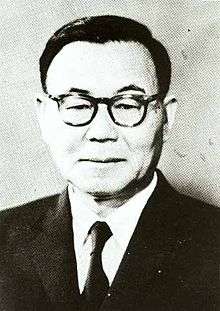 |
Yun Bo-seon Yun Boseon 윤보선 尹潽善 (1897–1990) |
4 | 12 August 1960 |
24 March 1962 |
1960 — 82.2% | Democratic (1960–1962) New Democratic (1962) | |
| The only President of the Second Republic of Korea. Park Chung-hee took de facto control over the country through the May 16 coup in 1961. | ||||||||
| Chairman of the Supreme Council for National Reconstruction | ||||||||
| — |  |
Park Chung-hee Bak Jeonghui 박정희 朴正熙 (1917–1979) |
— | 24 March 1962 |
17 December 1963 |
Acting President | Military | |
| Park Chung-hee was de facto leader of the country after leading the May 16 coup in 1961, which effectively overthrew the Second Republic of Korea. Park also became Acting President after Yun Bo-seon's resignation in 1962. | ||||||||
| President of the Third Republic | ||||||||
| 3 |  |
Park Chung-hee Bak Jeonghui 박정희 朴正熙 (1917–1979) |
5 | 17 December 1963 |
30 June 1967 |
1963 — 46.6% | Democratic Republican | |
| 6 | 1 July 1967 |
30 June 1971 |
1967 — 51.4% | |||||
| 7 | 1 July 1971 |
26 December 1972 |
1971 — 53.2% | |||||
| The only President of the Third Republic of Korea. Successfully industrialized South Korea and improved the economy significantly. He also proposed a range of significant policies, movements, and diplomatic pacts that contributed to constructing modern South Korea. | ||||||||
| Presidents of the Fourth Republic | ||||||||
| (3) |  |
Park Chung-hee Bak Jeonghui 박정희 朴正熙 (1917–1979) |
8 | 27 December 1972 |
26 December 1978 |
1972 — 99.9% | Democratic Republican | |
| 9 | 27 December 1978 |
26 October 1979 |
1978 — 99.9% | |||||
| The first President of the Fourth Republic of Korea. Assassinated by Kim Jae-kyu, the director of Korean Central Intelligence Agency (KCIA). | ||||||||
| During this interval, Prime Minister Choi Kyu-hah (최규하 / 崔圭夏), was Acting President. | ||||||||
| 4 | 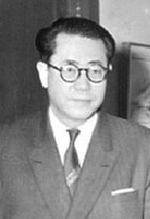 |
Choi Kyu-hah Choe Gyuha 최규하 崔圭夏 (1919–2006) |
10 | 6 December 1979 |
16 August 1980 |
1979 — 96.7% | Independent | |
| The second President of the Fourth Republic of Korea. Chun Doo-hwan took de facto control over the country by leading Coup d'état of December Twelfth in 1979. Presided at the time of the Gwangju Democratization Movement in 1980. | ||||||||
| During this interval, Acting Prime Minister Pak Choong-hoon (박충훈 / 朴忠勳), was Acting President. | ||||||||
| 5 | 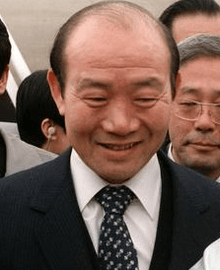 |
Chun Doo-hwan Jeon Duhwan 전두환 全斗煥 (1931–) |
11 | 1 September 1980 |
25 February 1981 |
1980 — 99.9% | Democratic Justice | |
| The third President of the Fourth Republic of Korea. | ||||||||
| President of the Fifth Republic | ||||||||
| (5) |  |
Chun Doo-hwan Jeon Duhwan 전두환 全斗煥 (1931–) |
12 | 25 February 1981 |
25 February 1988 |
1981 — 90.2% | Democratic Justice | |
| The only President of the Fifth Republic of Korea. | ||||||||
| Presidents of the Sixth Republic | ||||||||
| 6 |  |
Roh Tae-woo No Taeu 노태우 盧泰愚 (1932–) |
13 | 25 February 1988 |
25 February 1993 |
1987 — 36.6% 8,282,738 |
Democratic Justice (1987–1990) Democratic Liberal (1990–1992) Independent (1992-1993) | |
| The first Administration of the Sixth Republic of South Korea and the first president after the introduction of direct free and fair elections. Roh remained committed to democratic reforms, and also hosted the 1988 Summer Olympics in Seoul. Formerly served as a ROK Army general, an ally and friend of the previous President of the Fifth Republic Chun Doo-hwan. | ||||||||
| 7 |  |
Kim Young-sam Gim Yeongsam 김영삼 金泳三 (1929–2015) |
14 | 25 February 1993 |
25 February 1998 |
1992 — 42.0% 9,977,332 |
Democratic Liberal (1993–1995) New Korea (1995–1997) Independent (1997-1998) | |
| The second Administration of the Sixth Republic of South Korea. The first democratic activist to be elected president. Kim further attempted to reform the government and economy. He had former President Chun Doo-hwan and Roh Tae-woo arrested on charges of corruption and treason, winning convictions against both, but later pardoned them on the advice of then President-elect Kim Dae-jung. Kim Young-sam also granted amnesty to thousands of political prisoners, and removed the criminal convictions of pro-democracy protesters who had been arrested during the Gwangju massacre in the aftermath of the Coup d'état of December Twelfth. Led an anti-corruption campaign, requiring government and military officials to publish their financial records, precipitating the resignation of several high-ranking officers and cabinet members. Presided over the International Monetary Fund bailout of South Korea following the financial crisis of 1997. | ||||||||
| 8 | .png) |
Kim Dae-jung Gim Daejung 김대중 金大中 (1924–2009) |
15 | 25 February 1998 |
25 February 2003 |
1997 — 40.3% 10,326,275 |
NCNP (1998–2000) New Millennium Democratic (2000–2002) Independent (2002-2003) | |
| The third Administration of the Sixth Republic of South Korea. The second democratic activist President of South Korea. Kim formulated and implemented the Sunshine Policy of engagement with North Korea, and became the first South Korean president to visit North Korea in 2000, meeting North Korean leader Kim Jong-il in Pyongyang. Nobel Peace Prize recipient in 2000 "for his work for democracy and human rights in South Korea and in East Asia in general, and for peace and reconciliation with North Korea in particular."[1] Co-hosted the 2002 FIFA World Cup with the neighboring country of Japan. | ||||||||
| 9 |  |
Roh Moo-hyun No Muhyeon 노무현 盧武鉉 (1946–2009) |
16 | 25 February 2003 |
25 February 2008 |
2002 — 48.91% 12,014,277 |
Millennium Democratic (2003)
Uri (Opened Our) (2004–2007) | |
| From 12 March 2004 until 14 May 2004, Prime Minister Goh Kun (고건 / 高建) served as an Acting President for Roh Moo-hyun. | ||||||||
| The fourth Administration of the Sixth Republic of South Korea. The second liberal/centrist President of the Sixth Republic. Roh maintained the existing Sunshine Policy of engagement towards North Korea. The first President of the Sixth Republic to be tried for impeachment. Roh's planned to the create an administrative capital, but he was set back by the Constitutional Court's ruling that the relocation of the capital was unconstitutional. Instead Roh opted for an administrative center. Served as Member of the National Assembly for Dong District, Busan (1988–1992). | ||||||||
| 10 | .jpg) |
Lee Myung-bak I (Yi) Myeongbak 이명박 李明博 (1941–) |
17 | 25 February 2008 |
25 February 2013 |
2007 — 48.7% 11,492,389 |
Grand National (2008–2012) Saenuri (New World) (2012–2013) | |
| The fifth Administration of the Sixth Republic of South Korea. Lee implemented a tougher policy with regard to North Korea, through the MB Doctrine. Reversed the U.S. beef import arrangement in 2008, triggering a series of anti–U.S. beef import protests. Attempted to scale down the development of Sejong into a hub of education, science and business rather than a national administrative center, with the support and backing of the former Prime Minister Chung Un-chan. Growing conflicts with North Korea resulted in the ROKS Cheonan sinking and bombardment of Yeonpyeong. Lee also became the first South Korean president to visit Dokdo, which further escalated tensions with Japan in 2012 before the end of his term. Served as Member of the National Assembly for Jongno District (1996–1998), Mayor of Seoul (2002–2006). | ||||||||
| 11 |  |
Park Geun-hye Bak Geunhye 박근혜 朴槿惠 (1952–) |
18 | 25 February 2013 |
10 March 2017 |
2012 — 51.6% 15,773,128 |
Saenuri (New World) (2013–2017) Liberty Korea (2017) | |
| From 9 December 2016 until 10 March 2017, Prime Minister Hwang Kyo-ahn (황교안 / 黃敎安) served as an Acting President for Park Geun-hye. | ||||||||
| The sixth Administration of the Sixth Republic of South Korea. Park is a daughter of former President Park Chung-hee, and she was the first female President of South Korea. She was the second president to be tried for impeachment and the first president to be successfully impeached following a unanimous (8-0) vote on 10 March 2017 by the Constitutional Court to remove her from office. Served as Member of the National Assembly for Dalseong County (1998–2012), and as a party list member (2012). | ||||||||
| During this interval, Prime Minister Hwang Kyo-ahn (황교안 / 黃敎安) was Acting President. | ||||||||
| 12 | _cropped.jpg) |
Moon Jae-in Mun Jaein 문재인 文在寅 (1953–) |
19 | 10 May 2017 |
Incumbent | 2017 — 41.1% 13,423,800 |
Democratic | |
| The seventh President of the Sixth Republic of South Korea. The third liberal President of South Korea. Assumed the office immediately upon election on 10 May 2017, following the impeachment of Park Geun-hye. Served as Member of the National Assembly for Sasang (2012–2016). | ||||||||
Timeline

See also
References
- ↑ "The Nobel Peace Prize 2000". Nobel Foundation. Retrieved 2008-10-20.